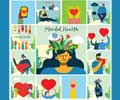Two in five young people receiving services are experiencing significant concurrent mental health and substance use problems, finds a study.

"We know that youth with mental health and substance use issues would benefit greatly from early intervention and specialized care, but most are likely to remain undetected, some well into adulthood," said Dr. Joanna Henderson, Head of Research in CAMH's Child, Youth & Family Program and Project Co-Lead. "We found that when service providers use a standardized screening tool it gives them another strategy for understanding a youth's needs and ensures that when different services work together, they are speaking a common language."
Statistics uncovered during the study further illustrated the need for better pathways to care:
- Two in five youth screened positive for concurrent disorders (i.e. both mental health and substance use disorders).
- 52 per cent of male youth and 39 per cent of female youth across all age groups reported significant substance use concerns.
- 73 per cent of female youth and 58 per cent of male youth reported significant mental health concerns such as depression and anxiety. Advertisement
- 69 per cent of male youth and 56 per cent of female youth aged 12 to 15 reported behavioural concerns such as difficulties with impulsivity and inattention.
- 47 per cent of youth indicated suicide-related concerns at some point in their lifetime, with one in seven youth reporting they had thought about suicide in the past month. Advertisement
- 60 per cent of female youth and 41 per cent of male youth reported trauma-related distress.
Several system improvement recommendations were made based on the report's findings, including:
- Support for gender-sensitive approaches to care to address the different service experiences of male and female youth.
- Developmentally-informed services that reflect the differing needs of younger and older youth.
- Suicide-related services, including early identification of concerns and high intensity mental health services.
- Improved capacity to address co-occurring substance use and mental health problems.
- Implementation of a consistent screening process for mental health and substance use problems across sectors, given the high rate of substance use and mental health concerns in youth.
- Increased capacity for trauma-informed and trauma-specific care.
Source-Eurekalert















